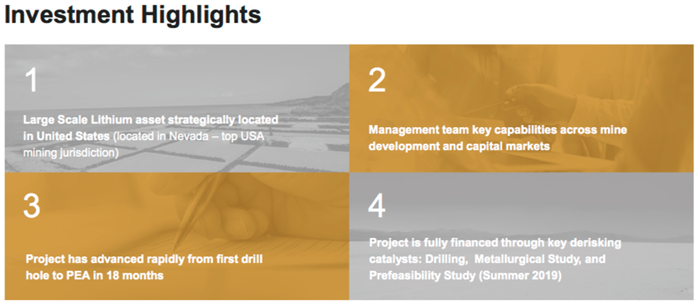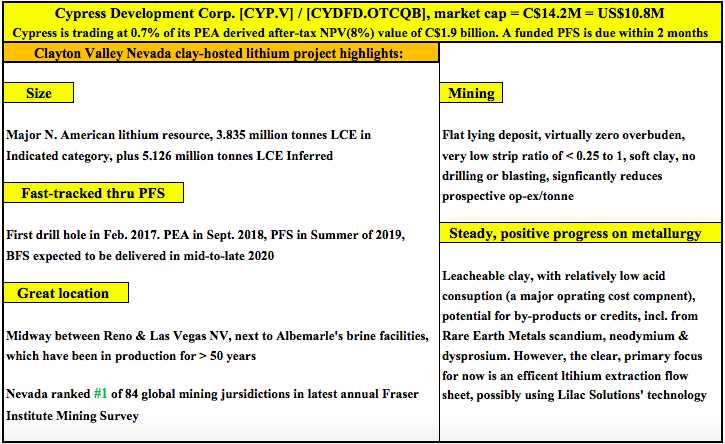Earlier this year, Cypress Development Corp. (TSXV:CYP) delivered a preliminary economic assessment (PEA) on its 100%-held Clayton Valley clay-hosted lithium project in Nevada (USA). The results were strong, (all figures post-tax, in Canadian dollars [CAS$]), an IRR [internal rate of return] of 32.7%; NPV [net present value](8%) = $1.95 billion upfront capex = $645.88 million; a 40-year mine life operating at 24,000 (24K) tonnes lithium carbonate equivalent (LCE) per year.
A fully funded pre-feasibility study (PFS) is expected in late August or early September. After the release of this important report, management will be in a position to dive deeper into talks with a number of strategic and/or financial partners that have already expressed interest [see new corporate presentation].
The next capital raise (or, if an investment at the project level, it would not require the issuance of new shares), will fund a pilot plant bank feasibility study (BFS). The BFS is expected to be delivered in mid- to late 2020.

Cypress partners with lithium extraction technology company
On July 15, Cypress and privately owned Lilac Solutions announced a successful demonstration of favorable lithium recoveries from Cypress' Clayton Valley project in Nevada. Lilac is a lithium extraction technology company based in California. Cypress' project is a large, clay-hosted lithium deposit containing 3.835 million tonnes LCE in the NI 43-101 Indicated resource category, plus 5.126 million tonnes LCE in the Inferred category [see NI 43-101 Technical Report (PEA)].
Cypress has developed an innovative leaching process that reduces the quantity of sulfuric acid needed (a major cost factor) to leach lithium from clay. After lithium is leached into solution (leachate), Lilac has proven it can extract it to produce a high-purity lithium solution, which can be processed with conventional equipment into high-purity lithium carbonate and hydroxide.

According to the news release, Lilac successfully extracted lithium from clay leachate, recovering 83% of the lithium, and rejecting greater than 99% of the sodium, potassium and magnesium impurities. Importantly, the remaining lithium in leachate can be recycled to allow for further recovery of lithium. The amount of additional lithium potentially recoverable in this manner is unknown at this time.
Cypress CEO Bill Willoughby, PhD, commented: "Lilac's results are promising and offer another path forward to efficiently recover lithium from our process solutions. Our project is a significant potential source of domestic lithium and we are pleased to be working with Lilac in applying their ion-exchange technology."
Several clay-hosted Li projects coming online in early 2020s
Readers should be aware that due to technical challenges associated with lithium extraction and/or prohibitive operating costs, no clay-hosted lithium project has reached commercial production. That's very likely to change as Ioneer Ltd (ASX:INR) Rhyolite Ridge and Bacanora Minerals Ltd.'s Sonora projects commence operations in the next few years.
Those two will likely be followed by Lithium Americas Corp (TSX:LAC).'s Thacker Pass project (Ioneer, Lithium Americas and Cypress Development each have projects in Nevada; Bacanora's flagship clay-hosted lithium project is in Mexico). Ioneer's project will get roughly half its revenue from the sale of boric acid.

If things continue to go well for Cypress, and management is able to line up one or more strategic partners to help fund development, the Clayton Valley project could reach commercial production a few years after Ioneer and Bacanora—perhaps around the same time, or a year behind, Thacker Pass.
I argue that while behind the others, Cypress is in the same league, especially once it delivers a PFS. Therefore, as a percentage of independently derived, after-tax NPV, it should trade in the same ballpark. However, that is not the case. Cypress is trading at less than 1% of its NPV, while peers trade at between 2.6% and 11.7% [see chart below].
Even if one assumes that Cypress is facing more equity dilution than peers, it is trading at a significant discount. For example, consider a hypothetical doubling in Cypress' share count to adjust for its earlier stage. The valuation would then be 1.5% of NPV. That's still a 79% discount to the average of the other names in the chart, 7.1% of NPV.
Next steps after a PFS this summer, a pilot plant and the BFS
Following behind much larger companies has its advantages. Management at Cypress, most notably CEO Bill Willoughby, who's a PhD mining engineer with nearly 40 years' experience, is learning a great deal from technical press releases and reports filed by Ioneer, Bacanora and Lithium Americas. Management is learning what to do, but also what not to do.

The same learning process will continue as Cypress and Lithium Americas go through their respective pilot plant stages. Ioneer and Bacanora already have pilot plants operating. However, each project is unique. Bacanora and Lithium Americas each have projects that are far different from Cypress' Clayton Valley, and different from each other's.
Global lithium supply next decade highly uncertain
One of the more exciting things for investors is something that has nothing to do with Cypress. It's the happenings, or lack of happenings, in Chile and Argentina, where project after project has been delayed or is outright stalled—not just early-stage projects, but projects at the BFS stage. These have stalled over the past year or more due to a falling lithium price and inability to arrange financing.
This is generating negative investment sentiment and headlines, but in the medium- to longer-term, it's great news for lithium pricing. Three years into a lithium price boom, albeit one that has tapered off lately, and production from Chilean brine operations has barely budged. There are about a dozen brine projects in Argentina, from pre-drilling to BFS-stage to fully funded, that simply are not moving forward.
I believe that the world might only get half to two-thirds of the brine production expected out of Chile and Argentina by the middle of the next decade. Said another way, if 500,000 tonnes LCE is expected from those countries in 2026, I would not be surprised if we did not see that amount until 2029.
No new brine projects have been able to ramp up to nameplate capacity, and time periods to reach just 70%-80% of full capacity are stretching out to four or five years instead of two or three. Orocobre is an example of this.
Conclusion
By the time Cypress gets its Clayton Valley project up and running in the middle of the next decade, I think the lithium pricing environment is going to be strong, perhaps very strong. By strong I mean US$12K–$16K/tonne. Very strong would be US$16K–$20K/tonne. The current price is around US$11K/tonne. Cypress is an earlier-stage investment opportunity than some of its peers, but should be squarely in the middle of the bunch once it has tabled a PFS later this summer.
If true, Cypress Development Corp. and a select few other clay-hosted lithium companies should be in a prime position to enter the market at an ideal time. And, Nevada will be a great location from which to launch the sale of high-purity lithium products to global auto manufacturing plants across North America.
